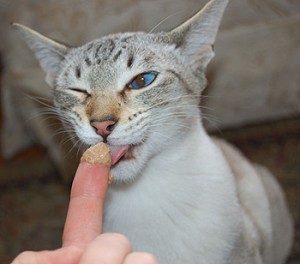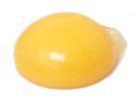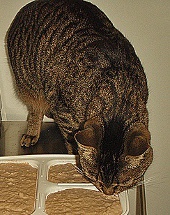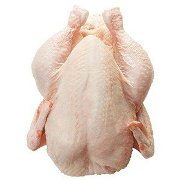Pets who switch to a fresh, healthy diet may show signs that seem unhealthy at first. Diarrhea, worms, excretions of the skin, and initial lethargy are indications that the new healthy diet is causing the body to discharge toxic materials. Sometimes things must get worse before they get better. Be patient and stay calm through this transitioning period. If you are concerned, or if the symptoms last longer than two weeks, talk to a reputable holistic veterinarian.
Dogs
 Good news for dog owners – it’s easier to switch a dog to a new food than a cat. Most dogs LOVE the fresh food. And it’s critically important to make sure you are not feeling trepid about the switch. Dogs are very tuned in to our emotions. If you’re scared, they’ll be scared. If you have a hesitant eater, try any or all of the following methods.
Good news for dog owners – it’s easier to switch a dog to a new food than a cat. Most dogs LOVE the fresh food. And it’s critically important to make sure you are not feeling trepid about the switch. Dogs are very tuned in to our emotions. If you’re scared, they’ll be scared. If you have a hesitant eater, try any or all of the following methods.
The most effective approach is a gradual switch. Start with a meal that is mostly comprised of the food the dog has been accustomed to, and mix in a small percentage of the new food. With each meal, gradually change the proportions until you are feeding your pet only the new food.
Fasting helps, and also has a cleansing benefit. Dogs and cats in the wild evolved on a natural fasting schedule. Some people are scared to fast their pets, but a few days without food is not bad for your dog or cat except in certain extreme and specific illness situations. See Fasting for more information.
There are also a number of toppings you can sprinkle on your pet’s new food, sort of like seasonings. Brewer’s yeast, tamari, parmesan cheese, and sardines are all examples of treats you can top the new food with to whet the  appetite. Don’t get too accustomed to topping the food, though. This is just a transitional method. Our favorite “seasoning” is FortiFlora because it also contains probiotics which can help ease the digestive transition.
appetite. Don’t get too accustomed to topping the food, though. This is just a transitional method. Our favorite “seasoning” is FortiFlora because it also contains probiotics which can help ease the digestive transition.
Cats
It’s important that you are confident with the new diet before attempting the change. Cats are very intuitive and will detect your apprehension. Be fully assured, yourself, before making the switch.
 Don’t interpret your cat’s reactions with human emotion. The cat is naturally programmed to imprint on foods it was introduced to during kittenhood. When the cat appears to prefer certain foods over others, it’s only because the other foods aren’t recognized as edible. Familiar food represents a sort of security blanket for survival. The degree of food imprinting varies from cat to cat.
Don’t interpret your cat’s reactions with human emotion. The cat is naturally programmed to imprint on foods it was introduced to during kittenhood. When the cat appears to prefer certain foods over others, it’s only because the other foods aren’t recognized as edible. Familiar food represents a sort of security blanket for survival. The degree of food imprinting varies from cat to cat.
Because of the stress that may come from removing familiar food completely, it’s often best to gradually introduce the new food mixed in with the old food, changing the proportions over time until the cat is only eating the new food.
Cats imprinted to dry cat food will take longer to adapt, and it is sometimes advisable to first switch your cat to a premium canned food, and then gradually mix in the new food once wet food has been accepted.
The favorite meat choice for the transition is chicken. At any stage, you may want to sprinkle appetizers (toppings) on the food.
Starting Out
Remove all current food well in advance, and stick to a regular feeding schedule. Make sure the environment is comfortable, you are feeling positive about the food, and there are no distractions from other animals. Present your cat with a small amount of the raw food. Don’t leave the food out for longer than an hour. If your cat accepts the new food from the onset, good! There is no need to take further steps.
If the cat is hesitant, and has been imprinted with dry cat food, go to Step 1. If the cat is hesitant, and has been imprinted with canned food, go to Step 2.
Step 1. For cats accustomed to dry food.
First, with confidence, try to feed the cat the new raw food. Make sure the feeding takes place at a regularly scheduled feeding time, and that you are relaxed and in a peaceful environment without distractions from other animals. Try finger feeding. Encourage your cat with affection and play, and  no trepidation. If the cat tries it, great! You’re on your way. Continue finger feeding until your cat seems full. Repeat finger feeding sessions throughout the day until you think the cat is ready to eat from a dish.
no trepidation. If the cat tries it, great! You’re on your way. Continue finger feeding until your cat seems full. Repeat finger feeding sessions throughout the day until you think the cat is ready to eat from a dish.
A trick that sometimes works is to dab a small amount of food on your cat’s nose. When the cat licks off the food, it’s taken the first step toward realizing the substance is edible. If the cat washes it off and refuses to trust the foreign food, you will probably need to transition to a different wet food first. Do not force the food into the cat’s mouth.
Some use a high quality canned cat food for the transitional intermediary food. This may not be necessary. Another transitional food is mushed cooked chicken with egg yolk. You can make this by steam-cooking some chicken and  food processing it. Add the yolk when cooled. Very few cats will not eat this.
food processing it. Add the yolk when cooled. Very few cats will not eat this.
Again, at the scheduled mealtime, try finger feeding and then dabbing food gently on the nose if the finger feeding alone doesn’t work. If this still doesn’t work, leave the cat alone in a cozy room with its bed, litterbox, water, and the food. Some cats will respond to your constant urging, others need privacy. Try to find out what type your cat is.
Once your cat starts eating the transitional food – be it the quality canned food or the chicken/yolk mixture – stick with that food for a little while until your cat looks comfortable with it. Then move on to Step 2.
Step 2. For cats accustomed to wet food.
Again, make sure that the food is introduced at a regularly scheduled feeding time and that the environment is calm and free of distractions from other animals.
Use the mushed cooked chicken and yolk described above for your transitional food. Once the cat is used to that food, try replacing the mushed steamed chicken with ground raw chicken, still adding some yolk. Your cat may eat this new mix with gentle finger feeding, or by leaving the cat alone with the food in a confined and comfortable environment. As described above, this means a relaxing, closed room with the cat’s bed, litterbox, water, and the food.
 If your cat doesn’t eat this ground raw chicken with egg yolk, revert to the steamed mushed chicken and yolk that the cat is used to, but during the next meal, substitute 50% of the steamed chicken with ground raw chicken. Cooked chicken with yolk is not a complete meal, so you mustn’t feed this to your cat indefinitely.
If your cat doesn’t eat this ground raw chicken with egg yolk, revert to the steamed mushed chicken and yolk that the cat is used to, but during the next meal, substitute 50% of the steamed chicken with ground raw chicken. Cooked chicken with yolk is not a complete meal, so you mustn’t feed this to your cat indefinitely.
Once the cat is comfortable with the 50/50 mix, switch to 100% ground raw chicken with egg yolk. Stick with this for a little while before moving on. Transitioning times and methods vary from cat to cat. It’s possible your cat may take to the new food without having to gradually introduce it.
If you’re having difficulties, you might want to start by mixing in a small proportion of the new raw food into the wet food your cat is accustomed to. If you mix in about a teaspoon of the new food, most cats won’t even notice. Again, make sure the environment is relaxed and free of distractions. Use food that is as fresh as possible, with the entire chill taken off, but not warm.
Be patient. Don’t hold back if your cat progresses readily, but don’t rush if more time is necessary from stage to stage.
Summary
Remember that all cats are different. Don’t humanize their reactions. Your cat learned that the food it ate as a kitten was necessary for survival. Different cats will need different amounts of patience for them to relearn a new food.
Methods vary depending on the cat. Find out if your cat eats more comfortably with you around or alone in a trusted, confined space.
 It’s up to you and your cat whether you use a transitional food in the process. You also have a great deal of leeway with how gradually you wish to introduce the new foods. Be patient, confident, and trustworthy.
It’s up to you and your cat whether you use a transitional food in the process. You also have a great deal of leeway with how gradually you wish to introduce the new foods. Be patient, confident, and trustworthy.
Stay with chicken as your meat for the beginning. You don’t want to upset your cat by introducing a new meat, which might cause vomiting. This can be the case with red meats. A variety in diet is good, though, to be assured of a comprehensive range of nutrients, but introduce new foods after your cat is well settled into the new feeding routine.
Cats are sensitive to meats that are spoiled, so make sure the food you are feeding them is fresh, especially during the transitional period. You don’t want to inadvertently compromise the transitional process.
You may want to add water to the food. Some cats like a smooth consistency that is easy to lap up.
Always remain calm. Getting frustrated is natural, and some waste is to be expected. Also, fasting can be part of the transition process. Some cat people are against fasting, but unless your cat has compromised health, the fast is a natural process that both cats and dogs go through in the wild. Your cat will not starve itself to death.  The only thing you have to be cautious of is an underlying precondition, a serious illness your cat may already have. See Fasting for more information. If your cat continues to not eat, the problem may have nothing to do with switching to a new food, and you need to see a holistic veterinary professional.
The only thing you have to be cautious of is an underlying precondition, a serious illness your cat may already have. See Fasting for more information. If your cat continues to not eat, the problem may have nothing to do with switching to a new food, and you need to see a holistic veterinary professional.